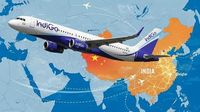After more than five years of suspended air links and frosty relations, India and China are preparing to resume direct flights between their major cities, signaling a cautious but significant thaw in ties between Asia’s two largest countries. The long-awaited move, announced by India’s Ministry of External Affairs (MEA) and widely reported by outlets including AP, BBC, and Global Times, marks a new chapter in a relationship that has weathered border clashes, pandemic disruptions, and shifting global alliances.
Direct flights between India and China were abruptly halted in early 2020 as the COVID-19 pandemic swept across the globe. But the pandemic was only part of the story. That same year, a deadly clash in the Galwan Valley along the disputed Himalayan border left at least 20 Indian and four Chinese soldiers dead, according to BBC. The violence—the worst between the two nations in decades—froze high-level political engagement and led to a protracted diplomatic chill. For travelers, businesspeople, and students, the absence of direct flights meant costly detours through Singapore, Bangkok, or Hong Kong, making journeys longer and more expensive, as Skift noted.
Now, as the world emerges from the pandemic and both countries seek to recalibrate their foreign policies, the skies are set to open once again. According to a statement from India’s MEA, direct air services will resume by late October 2025, following sustained technical discussions and the finalization of a revised Air Services Agreement. The flights will initially connect designated points in both countries, with the winter schedule marking the official restart, subject to the commercial decisions of the airlines and fulfillment of all operational criteria. The agreement is the result of months of behind-the-scenes talks between civil aviation authorities, building on earlier diplomatic engagements and a shared desire to normalize relations.
India’s largest carrier, IndiGo, was the first to announce its return to China. Beginning October 26, 2025, the airline will operate a daily, non-stop service between Kolkata and Guangzhou, using its Airbus A320neo aircraft. "We are proud to be amongst the first to resume direct connectivity to China from two points in India. This will once again allow seamless movement of people, goods, and ideas, while also strengthening bilateral ties between the two of the world’s most populous countries and fast-growing economies," said IndiGo CEO Pieter Elbers in a statement, as reported by Global Times and The Times of India. Subject to regulatory approvals, IndiGo also plans to launch a Delhi-Guangzhou route soon. Air India, meanwhile, is expected to resume direct flights from Delhi to Shanghai by the end of the year, according to Skift and The Times of India.
The resumption of flights is more than a logistical convenience; it’s a diplomatic signal. The Indian government has framed the move as part of its “approach towards gradual normalization of relations between India and China,” according to a statement cited by AP and BBC. The MEA emphasized that restoring direct air connectivity will “further facilitate people-to-people contact” and “contribute towards gradual normalization of bilateral exchanges.” This sentiment was echoed by Chinese state media, with the Global Times hailing the decision as a “pragmatic step” vital for the normalization of relations. Long Xingchun, a professor at Sichuan International Studies University, told the publication that the resumption of direct flights is “a vital criterion to test whether China-India relations normalize, as China-India relations have notably warmed up recently.”
Several factors have contributed to this warming trend. Over the past year, Beijing and Delhi have taken incremental steps to rebuild trust and de-escalate tensions along their ill-defined, 3,440-kilometer border. In October 2024, the two countries agreed on new patrolling arrangements to reduce the risk of further clashes, as reported by BBC. China has also begun allowing Indian pilgrims to visit religious sites in the Tibet Autonomous Region, while India has restarted visa services for Chinese tourists and agreed to resume talks on opening border trade through designated passes. These steps, though modest, have helped lay the groundwork for broader engagement.
High-level diplomacy has played a crucial role. In late September 2025, Indian Prime Minister Narendra Modi traveled to Tianjin, China, for the Shanghai Cooperation Organisation (SCO) summit—his first visit to China in seven years. There, he met with Chinese President Xi Jinping, and the two leaders reaffirmed their commitment to normalizing ties. The meeting was described by Indian officials as an “ice-breaker,” paving the way for the subsequent aviation agreement. Chinese Foreign Minister Wang Yi’s visit to Delhi in August 2025 further underscored the desire to move from rivalry to partnership, with Wang stating that India and China should see each other as “partners” rather than “adversaries.”
Geopolitical shifts have also played a part. India’s relationship with the United States has grown more complicated in the wake of President Donald Trump’s imposition of steep tariffs on Indian imports, a development that some analysts believe nudged Delhi and Beijing closer together, as Skift and BBC observed. Chinese ambassador to India Xu Feihong even described the US as a “bully” for its trade policies, highlighting the changing dynamics in the region.
For the thousands of Indians who study, work, or do business in China, the reopening of direct flights is particularly significant. Long Xingchun pointed out that “there have been more Indians studying, doing business, or traveling in China than Chinese in India.” He expressed hope that the resumption of air services would prompt India to simplify visa processes for Chinese citizens, further deepening people-to-people exchanges. Himadrish Suwan, chairman of the Confederation of Young Leaders of India, called the development “an encouraging sign” that could “help deepen the mutual understanding between the countries.” He added, “It will not only strengthen people-to-people exchanges, but also open new avenues for cooperation in trade, education, tourism, and youth-led engagement.”
IndiGo’s rapid return to the China market is no accident. The airline cited its “past experience and familiarity with local partners” as key factors in its ability to swiftly resume flights. The Kolkata-Guangzhou route will open for sale starting Friday, with additional connections to follow as regulatory approvals come through. Air India’s anticipated Delhi-Shanghai route will further expand options for travelers and businesses on both sides.
Officials and analysts alike see the resumption of direct flights as a practical measure that could help pave the way for greater economic and cultural interaction. The disruption of direct air links since 2020 severely curtailed business, tourism, and academic exchanges, and the restoration of these routes is expected to boost cross-border trade and strategic partnerships. As the civil aviation ministry put it on X (formerly Twitter), the move “will greatly enhance air connectivity, support people-to-people exchanges and contribute to the strengthening of economic collaboration between the two countries.”
While challenges remain—territorial disputes and mutual mistrust are not resolved overnight—the reopening of direct skies between India and China is a step toward a more connected and cooperative future. For now, travelers, students, and businesspeople can look forward to shorter journeys and, perhaps, a little more optimism in the air.






